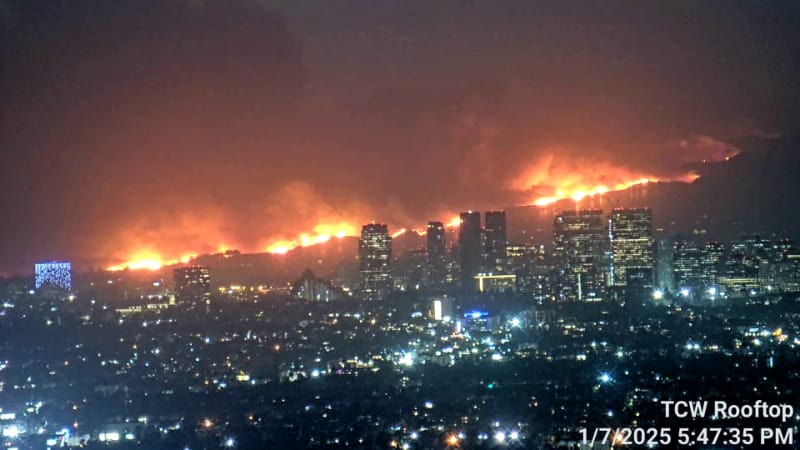Evercore ISI analysts have updated their estimate of the potential insurance and reinsurance market impact from the Los Angeles and Southern California wildfires, saying they believe the total could reach $20 billion to $25 billion, higher if the situation does not improve, while also suggesting the fires may be treated as one event for reinsurance purposes.
 Last week, in the first update on the wildfires from the Evercore ISI analyst team, they had provisionally said the insured losses could be between $6 billion and $8 billion.
Last week, in the first update on the wildfires from the Evercore ISI analyst team, they had provisionally said the insured losses could be between $6 billion and $8 billion.
Now, with the latest reports from fire officials stating that the number of structures damaged and destroyed by the fires burning in Los Angeles suburbs is expected to be above 12,300, the analysts have updated their estimate.
“While the situation is fluid, we think the insured losses will be in the $20b-25b range, with potential for it to move higher if the fires continue to spread uncontained,” the analysts wrote in their latest report.
Adding some details on the potential impacts to insurance carriers under their coverage, “We see the largest portion of losses hitting the homeowners’ market, with State Farm and Farmers as #1 and #2 market share for Homeowners in California, but ALL at ~6%, TRV at ~4%, CB at ~2.6% and AIG at <0.5%, with HNW homeowners carriers such as CB, Pure, CINF and AIG likely most impacted given high median home values in the areas (AIG has reinsurance protection). While our CA market shares are for the entire state, we believe many carriers have reduced exposure in wild-fire prone areas and thus the shares could overstate the actual exposure..
The Evercore ISI analysts also explained that, “There will also likely be a CA FAIR Plan assessment as we believe its loss could approach ~$6b vs $200m in capital and $2.5b in reinsurance protection.”
While adding on the reinsurance markets that, “We expect the reinsurers to incur losses similar to Hurricane Milton (~$25b insured loss) given similar sizing of the event with ~1% share each of the total insured loss.”
Perhaps more interesting though, is that the analysts believe that carriers may be able to treat at least some of the fires as a single loss event, depending on the terms of their reinsurance arrangements.
They explained, “While we do not expect much of these losses to hit reinsurers, we do expect these fires to be treated as one event which could help carriers reach reinsurance coverage.
“Many reinsurance clauses on brush fires have both an hour and distance clause, which is typically 168 – 240 hours and a radius of 150 miles. Our quick distance check shows the Palisades and Eaton fires are ~25 miles apart, and began within 2 days of one another so fit within both clauses that allow them to be treated as one event.”
There is no way to know how exactly these separate fires will be treated under reinsurance treaties without visibility of the terms of reinsurance coverage.
But this subject, of multiple separate loss events or one much larger loss event, will have significant ramifications for how much access to their reinsurance capital arrangements affected insurers will have for these California wildfires.
Catastrophe bond fund managers we had spoken with last week all said they would expect the fires to be distinct events, meaning the main threat to cat bonds and other private insurance-linked securitis (ILS) arrangements would be to aggregate, or frequency covers.
But, should it turn out the Evercore ISI analysts are right, this could increase the volume of claims from the fires that flows to reinsurance, potentially also to certain ILS positions and strategies.
In addition, equity analysts at BMO Capital Markets also updated their estimate for insured losses from the fires late on Friday.
Having originally estimated a low single digit billion dollar loss, right after the first damage reports suggested just over 1,000 structures destroyed, they say, “We now use ~$20Bn as our real-time+1-day insured loss estimate.”
The BMO analysts also said that, at this level of industry loss, the event will activate reinsurance for certain insurers, with Allstate, Chubb, Cincinnati Financial, and The Hartford highlighted as ones expected to benefit from recoveries under their occurrence reinsurance towers.
Estimates from other sources continue to suggest a range beginning at $10 billion, with many saying around $20 billion and a few suggesting it could reach higher still.
In fact, Jon Schneyer, research director at catastrophe analytics specialist CoreLogic, is reported widely to have said that “a $20 billion to $30 billion, insured loss event is now on the table.”
While, analysts at Jefferies said this morning that preliminary insurance industry loss estimates are in this $10-20bn range, but that given how little of the fires are contained still, the Jefferies analyst team expect losses to be at the higher end of this range, or somewhat above.
Jefferies analyst team also commented on the question of whether the fires could be deemed a single event, under reinsurance, saying, “Reinsurance treaties typically have hours and radius clauses. A typical hours clause would group a same peril occurring over a 7-10 day period as one. Radius restrictions would often group same perils occurring within a 250-mile radius. While these are typical terms, there is room for variance. We do not believe that it is possible to determine which contracts group the fires into one event and which would not, but we would expect the majority of reinsured exposure to be lumped into a single event.”
Finally, it’s worth also noting that forecaster Accuweather has increased its estimate for economic losses from the wildfires, now stating that it expects the total financial costs could reach to between $250 billion and $275 billion, almost doubling the total from its previous $135 billion to $150 billion range.
It’s important to note that Accuweather attempts to incorporate all financial, knock-on and interruption type costs or expenses that are caused by a catastrophe event into its economic loss estimates, as well as damage to infrastructure and utilities, to interruption related costs, rebuilding, relocation, cleanup lost wages and displacement, among others.
While many feel the Accuweather estimates can be too high, it’s a further helpful indicator of the financial impacts to California and the United States, which are clearly rising.
There are other estimates also doing the rounds that suggest an ultimate insurance and reinsurance market loss closer to $30 billion is possible, if the wildfires cannot be brought under control.
Also read:
– LA wildfire losses to “notably exceed” $10bn, could approach $20bn: Gallagher Re.
– Mercury says LA wildfire losses to exceed reinsurance retention.
– LA fires: “Considerable attachment erosion” likely for some aggregate cat bonds – Steiger, Icosa.
– LA wildfires: Over 10k structures destroyed. Insured losses up to ~$20bn, economic $150bn.
– LA wildfire losses unlikely to significantly affect cat bond market: Twelve Capital.
– LA wildfires unlikely to cause meaningful catastrophe bond impact: Plenum Investments.
– JP Morgan analysts double LA wildfire insurance loss estimate to ~$20bn.
– LA wildfires: Analysts put insured losses in $6bn – $13bn range. Economic loss said $52bn+.
– LA wildfires bring aggregate cat bond attachment erosion into focus: Icosa Investments.





















 English (US) ·
English (US) ·